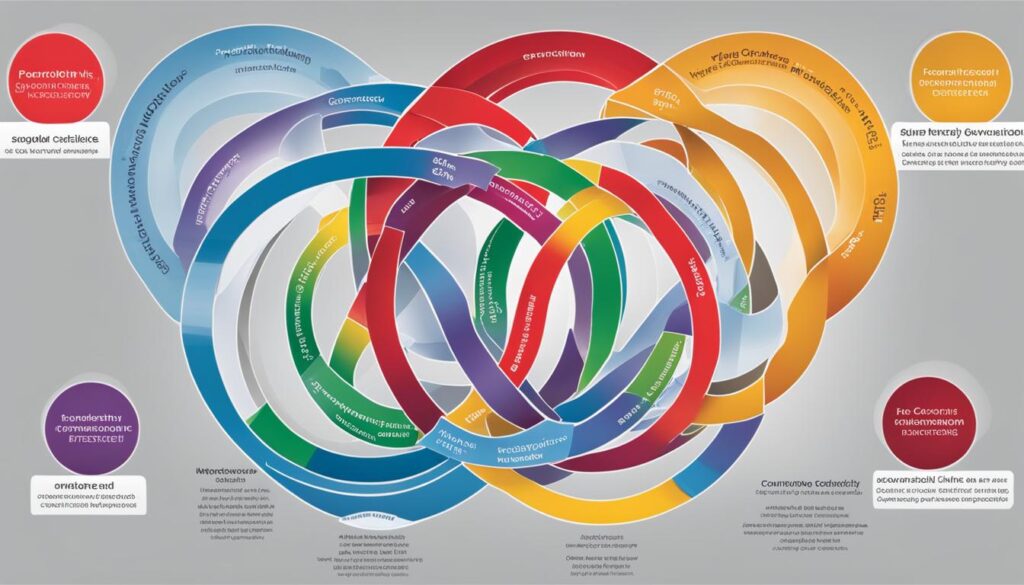Obesity prevention is a critical topic in the United States, with increasing prevalence across the country. Despite previous efforts, the nation has struggled to effectively combat this issue. However, there is still hope for success through the implementation of primary, secondary, and tertiary prevention strategies. These three levels, as defined by the Institute of Medicine, offer distinct approaches to preventing and managing obesity.
- Obesity prevention requires a multifaceted approach at different levels.
- Primary prevention focuses on reducing the incidence of obesity through education and lifestyle changes.
- Secondary prevention aims to identify individuals at risk and intervene early to prevent obesity.
- Tertiary prevention focuses on managing the complications and co-morbidities of existing obesity.
- A multidisciplinary approach and continuous evaluation are crucial for successful prevention efforts.
Takeaways>
Understanding Obesity as a Complex Issue
Obesity is a multi-factorial disorder influenced by both genetic and environmental factors. While genetics play a role in obesity, the primary causes can be attributed to social and cultural forces that promote unhealthy lifestyles. These forces promote an energy-rich diet and a sedentary lifestyle, leading to weight gain and obesity. To effectively prevent and manage obesity, it is crucial to address both genetic vulnerabilities and environmental factors through primary, secondary, and tertiary prevention strategies.
The Role of Genetics
Genetics plays a significant role in an individual’s susceptibility to obesity. Certain genetic variations can increase the risk of developing obesity by affecting metabolic processes, appetite regulation, and fat storage. However, it is important to note that genetics alone do not determine obesity. Environmental factors also play a crucial role.
Environmental Factors
Social and cultural factors heavily influence obesity rates. The food environment, characterized by the easy availability of energy-dense, nutrient-poor foods, contributes to unhealthy eating habits. Additionally, sedentary lifestyles brought about by technological advancements and the prevalence of desk jobs further exacerbate the problem. The social norms and values that prioritize convenience over health contribute to the obesogenic environment.
To address these complex factors, a comprehensive approach to obesity prevention is necessary. This approach involves implementing interventions at different levels of prevention: primary, secondary, and tertiary.
| Level of Prevention | Key Focus | Examples |
|---|---|---|
| Primary Prevention | Reducing the incidence of obesity through lifestyle changes and education | Implementing nutrition education programs, promoting physical activity in schools |
| Secondary Prevention | Identifying individuals at risk and intervening early to prevent the worsening of obesity | Regular health check-ups, counseling and support for individuals at risk |
| Tertiary Prevention | Managing the complications and co-morbidities associated with existing obesity | Weight-loss medications, bariatric surgery, lifestyle interventions |
Obesity prevention requires a comprehensive approach that addresses the genetic, social, and environmental factors contributing to the development of obesity. By implementing primary, secondary, and tertiary prevention strategies, we can effectively prevent and manage obesity, reducing its prevalence and improving the overall health of the population.
With a solid understanding of the complex nature of obesity, we can develop evidence-based interventions and programs that target the underlying causes. This holistic approach empowers individuals, communities, and healthcare systems to work together in the fight against obesity.
Primary Prevention Strategies for Obesity
A key approach to combating obesity is primary prevention, which focuses on reducing the number of new cases of obesity. By implementing effective interventions and programs, we can promote healthy eating habits, regular physical activity, and overall lifestyle changes (check out my post on healthy eating habits here). These strategies aim to address the root causes of obesity before they become problematic (see my post here).
Educating on Nutrition and Healthy Eating: Providing comprehensive education on nutrition and healthy eating habits is crucial in empowering individuals to make informed choices. This includes teaching individuals about the importance of a balanced diet, portion control, and the benefits of consuming whole, unprocessed foods.
Promoting Physical Activity: Encouraging regular physical activity is vital for preventing obesity. Schools and communities play a significant role in promoting physical activity through organized sports, physical education programs, and community fitness initiatives. By creating opportunities for exercise, we can help individuals develop healthy habits and maintain a healthy weight.
Implementing Policies to Limit Marketing of Unhealthy Foods: Restricting the marketing of unhealthy foods, especially to children, is a critical primary prevention strategy. By implementing policies that regulate the advertising and availability of unhealthy foods, we can reduce the impact of food marketing on consumer choices, particularly among vulnerable populations.
“Education on nutrition and healthy eating, promotion of physical activity, and policies restricting marketing of unhealthy foods are key primary prevention strategies for obesity.”
By targeting individuals before they develop obesity, primary prevention strategies can have a significant impact in reducing the overall burden of the disease. These proactive measures empower individuals to make healthier choices, create supportive environments, and foster lasting behavioral changes. By implementing a combination of these primary prevention strategies, we can take a step towards a healthier future.
[Table: Examples of Primary Prevention Strategies for Obesity]
| Primary Prevention Strategies for Obesity | Description |
|---|---|
| Educating on Nutrition and Healthy Eating | Comprehensive education on nutrition, promoting balanced diets and portion control. |
| Promoting Physical Activity | Including physical education programs, community fitness initiatives, and organized sports. |
| Implementing Policies to Limit Marketing of Unhealthy Foods | Restricting advertising and availability of unhealthy foods, particularly targeting children. |
Secondary Prevention Strategies for Obesity

Secondary prevention strategies play a vital role in reducing the prevalence of obesity in the population. These strategies focus on early detection and intervention to prevent further weight gain and the progression to more severe obesity.
Regular health check-ups are an essential component of secondary prevention. By monitoring weight and body mass index (BMI), healthcare professionals can identify individuals at risk of developing obesity and intervene early. This allows for timely interventions and increases the likelihood of successful outcomes.
Counseling and support are also crucial in secondary prevention strategies. By providing individuals with the knowledge, tools, and guidance they need, we empower them to make healthier choices and develop sustainable habits. Through tailored behavioral interventions, these strategies promote healthy eating and physical activity, helping individuals maintain a healthy weight and prevent the worsening of obesity.
“Early intervention is key in secondary prevention. By identifying individuals at risk and providing the necessary support, we can prevent the progression of obesity and its associated health complications.”
Here is a comprehensive table outlining various secondary prevention strategies for obesity:
| Secondary Prevention Strategies | Description |
|---|---|
| Regular health check-ups | Ongoing monitoring of weight and BMI to identify individuals at risk and intervene early |
| Counseling and support | Providing individuals with guidance and tools to make healthier lifestyle choices |
| Tailored behavioral interventions | Developing personalized plans to promote healthy eating and physical activity |
By implementing these secondary prevention strategies, we can effectively reduce the burden of obesity in our society. Early identification and intervention are key to preventing weight gain and the progression of obesity (check out my post on preventing weight gain here). Through counseling, support, and tailored interventions, we empower individuals to make positive changes and improve their overall health.
Tertiary Prevention Strategies for Obesity
Tertiary prevention strategies play a crucial role in minimizing the disability associated with existing obesity. These strategies focus on managing the complications and co-morbidities of obesity, such as diabetes, hypertension, and cardiovascular disease.
Medical interventions are an essential component of tertiary prevention. They may include weight-loss medications or bariatric surgery, depending on the individual’s medical condition and health goals. Weight-loss medications can help individuals achieve and maintain a healthier weight, while bariatric surgery is a more invasive option for those with severe obesity.
Lifestyle interventions also play a significant role in managing obesity and its associated complications. These interventions focus on helping individuals make sustainable lifestyle changes to manage their weight and improve overall health. They may involve a combination of dietary changes, regular physical activity, behavior modification techniques, and ongoing support from healthcare professionals.
By reducing the impact of obesity-related complications, tertiary prevention strategies can greatly improve the quality of life for individuals living with obesity.
It is important to note that tertiary prevention strategies are typically implemented alongside primary and secondary prevention efforts. By addressing the underlying causes of obesity and intervening at different stages, a comprehensive approach can be taken to prevent further weight gain and reduce the impact of obesity-related complications.
Example: Tertiary Prevention Program
One example of a tertiary prevention program is the bariatric care clinic at St. John’s Medical Center. This clinic offers comprehensive care for individuals with severe obesity, providing medical, nutritional, and psychological support. The program includes pre-operative assessments, surgery, post-operative care, and long-term follow-up to ensure the best possible outcomes for patients.
| Components of the Tertiary Prevention Program | Key Benefits |
|---|---|
| Pre-operative assessments and evaluations | Ensures suitability for bariatric surgery and identifies any potential risks |
| Bariatric surgery | Achieves significant weight loss and improvement in obesity-related complications |
| Post-operative care and support | Guidance and monitoring for optimal recovery and long-term success |
| Nutritional counseling and education | Supports healthy eating habits and proper nutrient intake post-surgery |
| Psychological support and counseling | Addresses emotional and behavioral factors contributing to obesity |
| Long-term follow-up and maintenance | Ensures ongoing support and management of weight and overall health |
Through a multidisciplinary approach, the bariatric care clinic at St. John’s Medical Center provides individuals with the necessary resources and support to manage obesity and improve their quality of life.
Promising Research Studies on Obesity Prevention

Research studies have provided valuable insights into effective obesity prevention strategies. These studies have explored various interventions and programs targeting different levels of prevention.
One example of primary prevention strategies is school-based interventions, which aim to promote healthy eating and physical activity among children. These interventions often include educational programs, access to nutritious meals, and increased opportunities for physical exercise. Research has shown that these interventions can significantly reduce the risk of obesity among school-age children.
“School-based interventions are crucial in shaping healthy behaviors among children and preventing obesity. By providing education, promoting nutritious meals, and encouraging physical activity, we can lay the foundation for a healthier future generation.”
Secondary prevention strategies, on the other hand, focus on individuals at risk of developing obesity. Behavioral interventions have been particularly effective in this regard. These interventions typically involve counseling, goal setting, and ongoing support to help individuals adopt healthier lifestyle habits. Studies have shown that behavioral interventions can lead to significant weight loss and prevent the progression to more severe obesity.
When it comes to tertiary prevention strategies, research has explored medical interventions for individuals with existing obesity. Bariatric surgery, for example, has been found to be an effective treatment option for individuals with severe obesity and related comorbidities. This surgical procedure can result in significant weight loss and improvement in obesity-related health conditions.
Overall, these research studies provide evidence-based approaches to obesity prevention at various levels. By implementing these strategies, we have the potential to prevent obesity, reduce its prevalence, and improve the overall health and well-being of individuals and communities.
Summary of Promising Research Studies on Obesity Prevention
| Primary Prevention | Secondary Prevention | Tertiary Prevention |
|---|---|---|
| School-based interventions | Behavioral interventions | Bariatric surgery |
| Educational programs | Counseling and support | |
| Access to nutritious meals | Goal setting | |
| Increased opportunities for physical exercise |
Challenges and Barriers in Obesity Prevention

Despite the availability of effective obesity prevention strategies, there are challenges and barriers that hinder their implementation. These challenges revolve around cultural and societal norms, limited access to healthy options, and a lack of awareness and education about the importance of obesity prevention. Additionally, resistance to lifestyle changes and a preference for quick-fix solutions further complicate the prevention efforts. To overcome these challenges, comprehensive approaches that address social, environmental, and individual factors are necessary.
1. Cultural and Societal Norms:
The prevailing cultural and societal norms often promote unhealthy behaviors, making it challenging to adopt healthier lifestyles. Social pressures, advertising, and societal perceptions of body image can influence individuals’ attitudes towards food and physical activity. These norms may perpetuate unhealthy eating habits and sedentary behaviors, hindering obesity prevention efforts.
2. Limited Access to Healthy Food Options and Physical Activity Opportunities:
Accessibility to healthy food options and opportunities for physical activity is not equitable across different communities and socioeconomic groups. Some areas lack grocery stores offering fresh produce, while others have limited safe spaces for outdoor activities. Limited access to nutritious food and limited opportunities for physical activity make it difficult for individuals to make healthier choices and engage in regular exercise.
3. Lack of Awareness and Education:
Many individuals and communities lack awareness and education about the importance of obesity prevention and the strategies available to them. This low level of awareness can contribute to misinformation and misunderstandings about nutrition, physical activity, and the consequences of obesity. Without proper education, individuals may not recognize the need for preventive measures or may struggle to implement them effectively.
4. Resistance to Lifestyle Changes:
Changing unhealthy habits and adopting healthier lifestyles can be challenging, especially when individuals face resistance from themselves or those around them. Behavioral change requires motivation, support, and perseverance. Some individuals may struggle to overcome ingrained behaviors and may resist making the necessary lifestyle changes to prevent obesity.
5. Preference for Quick-Fix Solutions:
There is often a preference for quick-fix solutions or fad diets that promise rapid weight loss, rather than sustainable lifestyle changes. These solutions often fail to address the underlying causes of obesity and can lead to cycles of weight loss and regain. This inclination towards quick fixes can impede the adoption of evidence-based prevention strategies that focus on long-term health.
To address these challenges and barriers in obesity prevention, a comprehensive approach is required. This approach should consider societal and cultural factors, improve access to healthy options and opportunities, increase awareness and education, provide support for lifestyle changes, and emphasize the importance of evidence-based strategies.
| Challenges and Barriers | How to Overcome |
|---|---|
| Cultural and Societal Norms | Conduct culturally sensitive education and awareness campaigns, challenge societal norms promoting unhealthy behaviors. |
| Limited Access to Healthy Options | Improve access to affordable healthy foods, foster community partnerships to create safe spaces for physical activity. |
| Lack of Awareness and Education | Implement comprehensive health education programs, engage healthcare providers to inform and educate individuals. |
| Resistance to Lifestyle Changes | Provide personalized counseling and support, focus on small, achievable goals to encourage gradual behavior change. |
| Preference for Quick-Fix Solutions | Promote evidence-based strategies through public health campaigns, debunk myths about rapid weight loss. |
By addressing these challenges and barriers, we can work towards implementing effective obesity prevention strategies, considering primary, secondary, and tertiary prevention approaches. Together, we can create an environment that supports healthy choices and empowers individuals to prevent obesity.
Importance of a Multidisciplinary Approach

Obesity prevention requires a collaborative and multidisciplinary approach that involves various stakeholders, including healthcare professionals, policymakers, educators, community leaders, and individuals themselves. By bringing together expertise from different fields, we can develop comprehensive and effective strategies to combat obesity.
One of the key advantages of a multidisciplinary approach is its ability to leverage diverse perspectives and insights. Healthcare professionals can contribute their medical knowledge and expertise in managing and preventing obesity-related diseases. Policymakers can help shape and implement policies that create supportive environments for healthy eating and physical activity. Educators can play a crucial role in promoting healthy behaviors among students. Community leaders can facilitate the development of programs and initiatives that target specific population groups. And individuals themselves can take responsibility for their own health and make informed choices.
By combining these efforts, we can ensure that obesity prevention strategies are evidence-based and tailored to the specific needs of different populations. A one-size-fits-all approach is seldom effective, considering the complex and multifaceted nature of obesity. Collaboration and coordination among various stakeholders can help us identify the most effective interventions and adapt them to the unique circumstances and challenges faced by different communities.
In addition to enhancing the effectiveness of prevention efforts, a multidisciplinary approach also improves the chances of successful implementation and long-term sustainability. When stakeholders work together, they can pool their resources, share best practices, and build upon each other’s strengths. This collaborative effort not only maximizes the impact of obesity prevention strategies but also ensures that they can be sustained over time, leading to lasting change.
Furthermore, a multidisciplinary approach promotes a holistic understanding of obesity and its underlying causes. Obesity is influenced by a complex interplay of biological, environmental, and social factors. By considering these various determinants, we can develop a more comprehensive understanding of the problem and devise targeted interventions that address them effectively.
In conclusion, a multidisciplinary approach is crucial in the fight against obesity. By bringing together healthcare professionals, policymakers, educators, community leaders, and individuals, we can develop comprehensive prevention strategies that are evidence-based, tailored to different populations, and sustainable over time. Only through collaboration and coordination can we effectively tackle the obesity epidemic and create a healthier future for all.
What are the different levels of obesity prevention and how do they differ in approach?
When it comes to preventing obesity, there are three primary levels of prevention: primary, secondary, and tertiary. Primary prevention focuses on promoting a healthy lifestyle and educating the public. Secondary prevention involves early detection and intervention for at-risk individuals. Tertiary prevention focuses on treatment and rehabilitation for those already affected. Here are some preventing obesity tips.
Evaluation and Continuous Improvement of Obesity Prevention Programs

Effective evaluation and continuous improvement are integral to the success of obesity prevention programs. By measuring the outcomes of prevention efforts and adapting strategies accordingly, we can ensure that our initiatives are evidence-based, effective, and responsive to the evolving needs of the population.
The Importance of Evaluation
Evaluation plays a crucial role in determining the impact of obesity prevention programs. By assessing key metrics and indicators, such as changes in obesity rates and improvements in health behaviors, we can gain valuable insights into the effectiveness of our strategies. Evaluation allows us to identify what is working well and what needs improvement, guiding our future program planning and modifications.
For example, through evaluation, we can determine whether education programs on healthy eating and physical activity are effectively influencing behavior change. We can also evaluate the reach and engagement of interventions in schools, communities, and healthcare settings to ensure that our efforts are having an impact at different levels of prevention.
Continuous Improvement for Better Outcomes
Continuous improvement is an ongoing process that involves learning from past experiences and making iterative changes to enhance the outcomes of obesity prevention programs. By analyzing evaluation data, recognizing areas of improvement, and implementing evidence-based modifications, we can achieve better results and maximize the effectiveness of our prevention efforts.
For instance, if evaluation reveals that a certain intervention is not yielding the desired outcomes, we can explore alternative strategies or adjust the implementation approach. Continuous improvement allows us to stay adaptive and responsive to the evolving needs and challenges associated with preventing obesity.
Collaboration and Knowledge Sharing
Collaboration and knowledge sharing are essential components of evaluation and continuous improvement. By engaging stakeholders from various sectors, including healthcare professionals, policymakers, educators, community leaders, and individuals themselves, we can foster a holistic approach to obesity prevention.
Sharing best practices and lessons learned through collaborative efforts can lead to the implementation of more effective strategies and enhance the overall impact of prevention programs. It allows us to tap into the expertise and diverse perspectives of different stakeholders, ultimately strengthening our ability to prevent obesity at different levels.
Stay Informed, Evolve, and Excel
To effectively prevent obesity, we must remain informed about the latest evidence and research findings in obesity prevention strategies. By staying up-to-date with the evolving landscape of obesity prevention, we can continuously evolve our programs and strategies to ensure their relevance and effectiveness.
Remember, the fight against obesity requires a collective effort. Through evaluation, continuous improvement, collaboration, and knowledge sharing, we can make significant progress in preventing obesity and improving the health and well-being of individuals and communities.
Table: Key Components of Evaluation and Continuous Improvement
| Evaluation Stage | Activities |
|---|---|
| Baseline Assessment | Measure obesity rates, health behaviors, and relevant indicators prior to program implementation. |
| Monitoring | Regularly track and collect data on obesity rates, health behaviors, program reach, and engagement. |
| Evaluation | Analyze data to assess the impact of prevention efforts and identify areas for improvement. |
| Modifications | Adapt strategies based on evaluation findings to enhance program effectiveness. |
| Continuous Improvement | Learn from past experiences, share knowledge, and make iterative changes for better outcomes. |
Conclusion
Obesity prevention is a complex issue that requires comprehensive strategies at different levels. Through primary prevention, we can reduce the incidence of obesity by promoting healthy lifestyle changes and education. By focusing on secondary prevention, we can identify individuals at risk and intervene early to prevent the worsening of obesity. Tertiary prevention plays a crucial role in managing the complications and co-morbidities of existing obesity.
To effectively combat obesity, it is essential to implement evidence-based prevention strategies and address the challenges and barriers that hinder their implementation. By utilizing a multidisciplinary approach involving healthcare professionals, policymakers, educators, community leaders, and individuals themselves, we can ensure that prevention efforts are comprehensive and tailored to the needs of different populations.
Continuous evaluation and improvement of obesity prevention programs are crucial to their success. By regularly measuring the outcomes of prevention efforts, we can gather valuable data that informs program planning and modifications. This approach allows us to adapt strategies to achieve better outcomes and ensures that prevention efforts remain evidence-based and effective for the evolving needs of the population.




